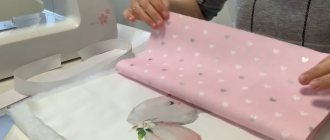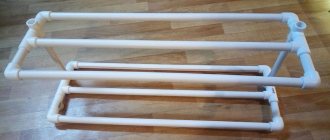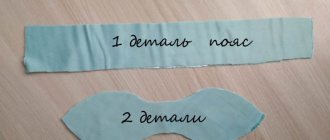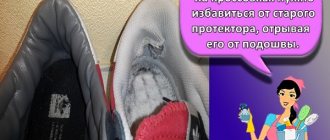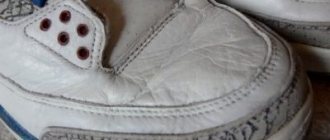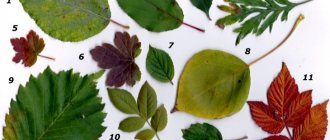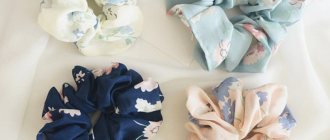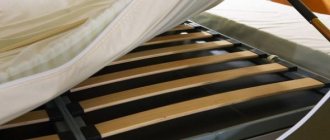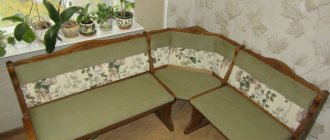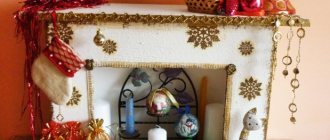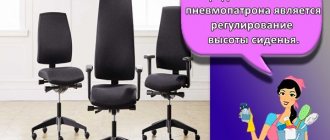All mothers have a lot of things to do, which they cannot always complete on time with a newborn baby. Leaving a baby alone in his crib is dangerous, and, for example, in the kitchen it is unlikely that you will be able to safely accommodate your baby. In this case, an excellent solution would be a nest for newborns, in which you can place the baby and move him around the house with you. The baby will always be under supervision, and you can calmly go about your business. Unfortunately, the offers on the modern market do not always meet the numerous requirements of responsible mothers: too high prices, poor colors, inappropriate shapes and other nuances make them think about sewing this necessary item themselves.
The benefits of a cocoon nest
The product is used to improve baby's sleep. In a cocoon, the baby behaves calmer and feels safe. This allows the child to be in a good mood and less capricious. The nests were developed specifically for the adaptation of premature babies to the external environment.
Historically, the device was replaced with diapers or towels folded into a pattern. In such a bed a closed space is created that resembles a mother's womb. It has been observed that the product helps:
- fall asleep faster, improve the quality of rest;
- protect the child from colic, improve the functioning of the digestive tract;
- improve hand-eye coordination.
The cocoon can be used as a carrier, changing table, or sleeping place. The specific purpose and terms of use depend on the type of product.
Cocoon-nest for a newborn: what is it and why is it needed?
A cocoon-nest is a bed that ideally fits the child’s size and follows his anatomical shape; it is a mattress with rounded sides, sometimes supplemented with an orthopedic pillow. Intended for babies from birth to 4 months.
Important! Do not leave the baby in the cocoon unattended, do not place the cocoon on surfaces from which the baby could even theoretically fall (dresser of drawers, changing table, edge of the bed or sofa, etc.).
A cocoon for a newborn has a number of advantages:
- creates a cozy space in which the child is more comfortable adapting to the “big world” (the special design of the cocoon is designed in such a way that the child, lying in it, feels as close as possible to the position in the mother’s womb), thanks to this, sleep in the nest is always calmer and longer , and the period of wakefulness increases significantly,
- The cocoon with the baby can be carried and placed anywhere, so a busy mother can take it with her without worry or remorse and do all the necessary things or just relax,
- if you put a newborn in a nest, you can sleep peacefully with him, without fear of crushing the baby or hurting him,
- if a child does not sleep well in a crib/stroller, etc., then the cocoon will fix this problem: due to its small size, it can be placed anywhere (in a stroller, crib, on a changing table, etc.),
- It’s convenient to lull the baby into a nest, rocking him slightly, and then you can move him to the right place without interrupting the child’s light sleep,
- thanks to its anatomical shape, the cocoon helps the development of the baby’s correct skeleton, and also reduces muscle tone,
- The cocoon helps the child cope with intestinal colic.
The baby in the cocoon feels more confident, as it is in a slightly grouped position, repeating the intrauterine one, in which the shoulders and spine take on a slightly rounded shape. This saves the child from regurgitation, gas formation and colic.
Tatyana Butskaya, pediatrician
https://prenatal.livejournal.com/97060.html
Requirements for a cocoon-nest
As with any children's household item, there are certain requirements for a cocoon-nest:
- the cocoon must be made of breathable, hypoallergenic and high-quality materials,
- the nest should follow the anatomical shape of the baby, for this you need to use the original patterns, which you will find below,
- the sides and mattress of the cocoon should be elastic and hold their shape well for the comfort and safety of the baby,
- The cocoon must be suitable in size for the baby.
Main types of infant nests
There are different types of “beds” for babies. You can sew any cocoon with your own hands. The choice of model is carried out individually. The following characteristics are useful:
- Diaper. Elementary option. It is a product cut according to the anatomical position of a baby.
- Pillow. Lightweight model. Suitable from birth. Used when feeding, during games, sleep. Intended for up to 5 months.
- Envelope. Something between a diaper and a pillow. The product provides tight fixation.
- Nest. Similar to a cradle with limited dimensions. The presence of sides is mandatory.
- Mattress. Used for sleep. Usually placed in a crib. It is rarely used to carry a baby.
Each option has its own pros and cons. With the right choice of materials and patterns, making the perfect nest for newborns with your own hands is not difficult.
Review of popular models
Cocoonababy Red Castle
This is the quality of the French brand where it all began. The set consists of a pear-shaped base (polyurethane foam material, cotton pillowcase), a leg bolster (attached under the knees, adjustable for height), and a safety belt. The ergonomic dense base will not lose its shape. The position of the baby is such that the head and torso are located at the same level, and the slightly bent legs are higher. The weight of the mattress does not exceed a kilogram. The cocoon is universal in function (sleep, travel, wakefulness, visiting the doctor). Place him in a stroller for walks or in a crib, but don't leave him unattended! The only drawback will be the price - about 11 thousand rubles. Additional items included:
- Blanket CocoonaCover. A convenient device that fits onto the mattress and is fastened with Velcro at the bottom. The child will be comfortable, it warms well and does not slip. Made from 100% cotton.
- Spare pillowcase. It is necessary for frequent regurgitation, surprise when changing a diaper or feeding. It is easy to wash and does not require special care.
Cocoon "Yawn"
Our production “Cloud Factory”. When compared with, there will be the following differences:
- The price is almost 2 times lower (5-6 thousand rubles).
- Weight – “Yawn” is one kilogram heavier.
- Included: Our manufacturer has an additional pillowcase, which the French manufacturer does not have.
They are similar in appearance, almost identical in size. Our manufacturer has provided additional accessories: a “milk + stars” blanket, a “Lamb” rocking chair, a lightweight Simple cover, and a thick Heat cover.
Farla baby shell
Also a domestic product. The peculiarity of this model is the use of low elasticity polyurethane foam. This material is also included in orthopedic mattresses. There are cavities at its base for ventilation (the child sweats less and overheats in the heat). No glue is used when assembling the base (environmentally friendly Farla production). Additional accessories include: blanket, pillowcase, carrier.
Babynest for newborns
Swedish development since 2003. Many models are made in our country. There are large cocoons for twins. This is not an ergonomic mattress, but a soft flat nest with sides that can be tightened with a string. Like the classic cocoon, it is no less popular and wins in price (2 times lower). The base is made of cold foam, the cover is made of cotton, and the sides are made of holofiber.
Nest cocoon for newborn Sleepyhead
The company that came up with this product, Enfant Terrible Design, operates in Sweden. It was founded by Lisa Furuland, who came up with a multi-functional item for her young son. A special feature is the longest service life (up to 8 months, there are models up to 3 years). The non-ergonomic base and sides are made of antibacterial polyester fibers, and the removable cover is made of cotton.
- Sleepyhead Deluxe – cocoon from birth to 8 months
- Sleepyhead Grand – for older babies (8 months – 3 years)
The downside is the price. It reaches 11 thousand rubles. Using a cocoon for a long time is not always useful (and sometimes even harmful). Not all manufacturers are available on our market. It’s good that domestic products are not inferior to foreign ones in quality. World famous companies:
- Red Castle – France
- Woombie – USA
- Babynest and Sleepyhead – Sweden
Cocoon mattress from the manufacturer Woombie
The second most popular manufacturer is the American company Woombie. Their cocoon mattresses have similar properties. The price of these products is also quite high. Considering that the cocoon will be used for only four months, the cost turns out to be a strong argument in favor of finding a simplified analogue.
Cocoon - Mario's Cradle
The Askona company has developed a cocoon - the Mario cradle, the material is very high-quality hypoallergenic highly elastic foam, the nest was developed together with Russian neonatologists for a child from one to six months. The set includes two cushions for placing under the legs of a child for different ages and a removable cotton cover with a lock. Securing the child using a belt with silent Velcro. The price is 4,448 rubles, but the cost of the cocoon is often included in promotions.
The nuances of individual production
The standard cocoon pattern for newborns can and should be adjusted to individual standards. The unique design will accurately copy the anatomical features of the baby. In this case, the base-bed must be sufficiently elastic and rigid.
The side walls should provide support and maintain their shape. To improve safety for securing the body, the structure is additionally equipped with fastener belts.
Tips for sewing items for newborns
Try to choose only natural fabrics. Be sure to check the certificates for them - the fabric should not have too bright or chemical colors.
- Do-it-yourself drawings on T-shirts - step-by-step instructions, necessary materials, advice from craftswomen. 120 photo ideas on how to make a print on a T-shirt
- DIY gift baskets are a universal gift for any occasion! 80 photo ideas for decorating baskets: romantic, formal, children's, Italian, Brazilian, for movie fans
- A DIY gift for your loved one: for Birthday, New Year, Valentine's Day, anniversary. 110 photo ideas for original and fun gifts that will surprise your loved one
If a young mother knows how to knit, she can knit a swaddling cocoon for newborns. Such a cocoon will be ideal for walks in the cool season.
The baby will definitely appreciate the warm and comfortable sleep in such a cocoon during walks in winter or autumn. Thanks to its cocoon shape, the baby in it will feel the same as inside the mother’s tummy.
Selection of working materials
It is better to sew a cocoon for newborns with your own hands from environmentally friendly, natural materials. The natural origin of the ingredients and hypoallergenicity are important.
Attention is paid to the composition of materials. The product must be permeable to air, preferably raw materials with a minimum degree of chemical processing (painting, impregnation).
Peculiarities
Recently, new mothers choose to sew a cocoon envelope for newborns with their own hands or buy a brand new model in the store for two reasons:
- The swaddling process becomes much easier.
- The baby's well-being in the diaper is marked by increased comfort and warmth.
A modern cocoon for the baby and the convenience of the mother.
It all has to do with the fact that the materials used and the folding structure resemble a mother’s tummy. Therefore, the baby feels as comfortable and protected as possible without constrained movements.
Original ideas for a diaper
Important characteristics of the diaper include:
● the composition includes predominantly natural and hypoallergenic fabrics (often cotton);
● easy to put on thanks to buttons, Velcro or zippers;
● the ability to choose an individual “cocoon”.
Lovely combination of colors and textures
The benefits of the things described are as follows:
● complete envelopment follows the shape of the child’s body;
● promotes restful and long sleep by maintaining warmth and comfort inside;
● the possibility of feeding is provided;
● the correct posture is ensured, which stretches the spine and forms the correct skeleton;
● the number of colics and their duration decreases;
● can be used for sleeping day and night, walking in the fresh air and even for swimming.
Important! Frequent and prolonged stay of the baby in the cocoon reduces muscle tone
Fabrics for the upper part of the product
The choice of material is based on an assessment of density, composition, and strength. The best option is pure cotton, which is not subject to rapid wear. Calico, flannel, and knitwear are best suited.
You can stop at linen, muslin, bike. As a last resort, use chintz. Fleece and plush are suitable for the outer part of the product. Combined options have recently become increasingly in demand.
What moms say
Overall there are a lot of positive reviews. What mothers of children who actively used the product note:
- The baby is comfortable in it and sleeps better.
- Transferring it to a mattress helps with colic, the baby settles down, begins to grunt and do “its own thing.”
- You can take it to bed, sleep together and not be afraid of crushing it. And finally get some sleep.
- I fix the handles so that in my sleep I don’t scratch my face or poke my fingers into my eyes. This period definitely comes for many children. And the cocoon helps.
Some parents also talk about negative aspects:
- Train and wean. Moreover, in the latter case you will have to “sweat.” The child does not want to fall asleep anywhere other than in the cocoon.
- It's hot in summer.
- Price!
Some babies can deprive their mother of sleep completely, and she is ready to give her last money to make life easier for herself and the child. Mom needs a resource! For care, care, everyday life, yourself. It's good that there are such baby gadgets that can help. Let motherhood not be a test for you, but be filled with love and the joy of communicating with your child!
Watch this video on YouTube
Internal filler
It is imperative to sew a cocoon for newborns with a compacted base. To form the sides you will also need filler. It is permissible to use both friable and rolled printed materials of natural or artificial origin.
When choosing, be sure to take into account the time of year to be used. It would be a good idea to think about your baby’s tendency to allergies. For example, wool or feathers are natural, but the risk of negative reactions of the body to them is high.
Note!
DIY satin ribbon bows: photos of original design ideas, step-by-step DIY master class- DIY hair bands - ideas for decorating homemade rubber bands + step-by-step instructions for making them yourself
- DIY shadow theater: step by step how to do it at home! 175 real photos
For the bottom it is better to use rolled dense fillers:
- coconut coir;
- sisal;
- linen.
In industrial versions, artificial options are more common: latex, memory foam. For sides, holofiber, polyester microfiber, and synthetic fluff are more often used.
Artificial fillings are usually cheaper, more durable, and easier to work with. This explains the high demand for such fillers.
Choosing the size of the cocoon diaper
The line of sizes of Sofuto cocoon diapers includes three sizes:
- S (for 0-3 months, height 62 cm)
- M (3-6 months, height 68 cm)
- L (7-9 months, height 74 cm)
The most popular diapers with zippers are in sizes S and M. We sew them en masse. Size L is made to order.
The most useful function of a knitted cocoon diaper is to carefully fit the baby and create a cozy limited space, like in a mother’s tummy. At the same time, the baby can freely move his legs and arms inside the cocoon. The zipper and the tab on the button do not allow him to undress, cover himself with a blanket, disturb himself in his sleep with involuntary shudders and scare him. Thanks to this diaper, a newborn’s sleep improves in the first months of life. The diaper also helps make feeding more comfortable.
For newborn babies, we recommend purchasing a diaper in size S. It is suitable from birth until 2-3 months, depending on the baby’s weight gain. If your baby finds it comfortable to sleep in them, from 3-4 months you can buy a cocoon with a zipper in size M.
We do not recommend that newborns purchase a diaper “for growth” in order to use it longer or in order to save money.
The photo below shows zippered diapers in sizes S and M. Comparing these sizes, you can see how much larger the M diaper is not only in length, but also in width
Also pay attention to the neck - how much wider it is compared to the S diaper
The next photo shows an almost two-month-old baby, 56+ tall. She is wearing a turquoise polka dot diaper, size S. The swaddling cocoon fits quite tightly, fitting well to the arms and neck. The baby is sleeping peacefully and calmly. And while awake, she will not be able to raise her arms high or stick her fingers through the collar.
In the photo below the baby is about the same height and age. She is wearing a diaper with unicorns in size M. The diaper fits very loosely and practically does not fit the baby. Thus, there is no effect on falling asleep better. The photo clearly shows how wide the collar is for her. If the baby raises her arms, she will be able to pull them out. For a newborn baby, this may be even more critical, since its dimensions are smaller than the babies in the photo.
To reap all the benefits of the Zip Cocoon Swaddle, shop the size that fits you now. A large cocoon diaper will not be effective for a newborn baby. And in the future it may not be necessary, since the older baby will learn to cope without a diaper.
Taking measurements
The basis is a ready-made cocoon pattern for a newborn. There are options in different sizes. The model marked “S” is suitable for premature babies. Size L is ideal for large babies. The pattern can be adjusted taking into account the height and weight of the baby.
It is not recommended to change the standard parameters taking into account the margin for growth. Cocoons are rarely used for children older than 6 months.
How to determine the right nest size for your baby
There are 2 sizes of cocoon nest:
- for premature babies - the length of such a cocoon is 50 cm in length and 25–30 cm in width, the nest is designed for children up to 3 kg,
- for full-term babies - a standard cocoon-nest of the same size with a slight adjustment to the child’s height, intended for babies from 3 to 6 kg, its length is 65–70 cm, and its width is 30–35 cm.
When sewing a cocoon, simply select the desired size and cut out the parts according to its size.
Advice! When the baby grows up and no longer fits in the nest, the latter can be used to place the baby on his tummy. To do this, you need to place it with its breast on the upper side of the cocoon so that it is located in the child’s armpits.
Calculation of the quantity of materials
Before sewing the nest, calculate the required amount of materials used: fabric, filling. For work, a material 50–70 cm long and 25–35 cm wide is usually sufficient. Add 10-15% to the standard pattern sizes for seams.
Adjustments can be made by the features of the model. The product may contain more parts.
Advantages and disadvantages of sewing a cocoon-nest yourself
Advantages of sewing a cocoon-nest yourself:
- possibility to choose materials and design,
- confidence in quality thanks to independent tailoring and selection of fabrics, filling, etc.,
- saving money,
- the opportunity to experience the warmth and love of creating something for your child with your own hands, and improving your relationship with him through this.
Disadvantages of sewing a cocoon-nest yourself:
- possible dissatisfaction with the result,
- time spent on selecting and purchasing the necessary materials,
- time spent on sewing the product.
Principle of operation taking into account the selected model
It is not difficult to understand how to sew a nest for a newborn. The product does not require special skill. There is no provision for performing complex actions that are beyond the capabilities of a novice seamstress.
Note!
- DIY bracelets | Selection of the best models and master class on making beautiful bracelets
- DIY bird feeder - interesting ideas on how to make it quickly and easily from scrap materials
- Do-it-yourself cold porcelain: the best options for porcelain products, step-by-step instructions and recipes for making it yourself (photo + video)
Classic nest
The finished pattern is drawn on paper, and if necessary, the parameters are adjusted. The pattern is cut out and transferred to the fabric. The side pieces are placed right sides together. The elements are secured at the edges with pins. The parts are sewn together, leaving a hole at the bottom free.
The finished part is turned inside out and ironed. A seam is made at a distance of 2 cm from the edge. This is where the tape will be inserted. Start working with the middle part of the product.
A pair of identical parts, together with a similar element made of padding polyester, are put together, cleaved, and sewn at the edges. The nest is assembled, filled with holofiber in the required parts, and tape is inserted.
Cutting, assembling and filling the product
First of all, we take the prepared material and pierce a pattern for it so that it is convenient to outline it. Don't forget about seam allowances. Next, on the outside, draw a line for the bottom of the nest. In places where the product is rounded, you need to make notches for easy stitching. It is important here that the cuts do not affect the product itself, but end where the allowances are.
The finished product will be tied with a cord. To do this, it is important to make a drawstring around the perimeter of the cocoon. There are two options for making a drawstring:
- Sew a ribbon over the seam that connects the bottom and top. The first line should go above the side, and the second - below.
- Cut or prepare a ribbon (5-6 cm wide) and 2 cm long than the circumference of the cocoon.
If you chose the second option, the cord will not be visible. You need to fold the fabric in half and stitch it. It is better to immediately place the lace there and align it well. After this, it is better to secure the drawstring with a sewing machine so that the lace does not slip out during use.
For convenience, when cutting, it is better to immediately cut out the padding polyester to fill the nest for your baby. The number of filler cuts also depends on the thickness of the material. In places where the product is rounded, the filler must also be rounded.
Cocoon envelope
Making a cocoon in the form of an envelope is also not difficult. Details are cut out of the fabric. Typically, fleece or plush is used for the inside of the product, and cotton for the outside. First, sew a pocket for the legs.
For the summer version, standard pattern sizes are used. For winter models, an increase of 10-15 cm is made at the edges. The parts are sewn together, the product can be supplemented with synthetic padding or left without filler.
The edges are finished using an overlocker. If you don’t have a device, you can use tape for finishing or lay a double connecting stitch. A hood is sewn to the resulting cocoon. The element is performed similarly to the previous one.
A zipper is sewn to the cocoon. The connection of the top and bottom parts is done on the wrong side. Finally, Velcro tape is sewn on to secure the edges.
How to use it correctly?
It is very comfortable for a newborn to sleep in a nest, because there he assumes the usual fetal position and is in a limited space. In order for the use of the product to be useful for the baby, it is necessary to choose the right size - it must correspond to the height of the baby.
Operating the mattress is quite simple, you just need to know a few adjustment and safety nuances:
- to adjust the limiter, first remove the cover from the socket;
- place the newborn on the mattress, while placing the head on the narrow side of the bedding;
- The removable stopper, which is located under the baby’s bottom, must be moved using Velcro so that it fits comfortably under the knees.
When completing the adjustment, remove the baby and put the cover on the nest. If necessary, the cocoon mattress can be placed in the crib or on the parents' bed.
All models of baby cocoons are sold complete with a special seat belt, which is securely attached to the mattress and holds the newborn on it. The belt does not interfere with the newborn at all - the baby can move his legs and arms freely. Let's take a closer look at how to secure a baby with a seat belt.
- Place the safety belt around the cocoon, with the short part facing you.
- Attach the edges of the belt to the mattress using Velcro.
- Place the newborn in the nest and secure the short edges with Velcro.
- Check the tightness of the belt - it should not put pressure on the baby's tummy. If necessary, loosen the short parts slightly.
Caring for a cocoon mattress is quite simple, because the kit always includes a waterproof cover. The cotton sheet, cover and waistband can be washed in a washing machine, following the manufacturer's recommendations on the label.
Diaper nest
These diapers are convenient to use from birth to 3 months. In appearance, the product looks like a mushroom with a large cap. The parts are cut out according to the pattern. First they work with the upper part of the product. The parts are sewn from the wrong side. A hole is left at the bottom.
Cuts are made at the folds, the product is turned right side out and ironed. The next step will be making an envelope for the legs. The parts are connected according to a similar principle.
Both blanks are connected together. The seams are finished with a blanket stitch or bias tape. You can make a diaper from 2 layers of fabric. This will save you from the need for unnecessary manipulations with the edges of the product. Velcro is attached to the sides to make it easier to fix the diaper during use.
Pillow for the legs or chest of a newborn
The second pad is universal. While the baby is lying on his back, you can place it under the baby’s legs, this will make the baby’s gas flow easier. But when you lay him on his tummy or teach him to crawl, this bagel pillow is placed under the baby’s chest so that he does not fall on his side and tries to hold his head. Babies from 4 months leaning on such a pillow will try to pull their legs under them and push off, thereby preparing to crawl in the future.
rogalik.jpg
111.1 KiB
411 Downloads
Pillow for newborns under the baby's legs or elbows. Helps the baby maintain its shape, stretch out on its arms or raise its legs.
- We sew together two parts of the bagel, leaving a hole for turning it inside out.
- Turn it inside out and stuff the pillow.
- Sew up the hole in the bagel.
- It turns out that in today's master class we touched on three very useful devices for babies. Sew it and you won’t regret it.
Safe decor
Many mothers strive to make not only comfortable, but also beautiful things for their babies. Newborns do not need special jewelry. Enough braid and ribbons. You can make soft bows and flowers. It is possible to use beautiful buttons and safe decor.
Small, sharp, poorly secured parts are not needed. They refuse fringes and other elements that can disturb the baby’s comfort. Children's clothes don't need extra decor. Jewelry often complicates the process of caring for the product and disturbs the baby.
Using a cocoon for a baby is an excellent opportunity to quickly adapt the baby to new conditions. The nest is easy to make yourself. This is not difficult and perfectly prepares the expectant mother for the arrival of the baby.
How to sew a reusable diaper for a newborn?
This piece of clothing also does not require a lot of fabric; you will save a lot by making it yourself.
- Print out the provided pattern.
Transfer it to a rubberized cloth. Finish the edges of the product by simply tucking them in or additionally sewing decorative braid here.
Sew buttons, cut and sew loops so that you can fasten a reusable diaper.
If you want to sew a set for a girl, then decorate the panties with ruffles made of fabric. A robe dress is also created from a small piece of fabric and is quite simple.
To implement the idea for the next master class you will need:
- textile;
- rubber;
- scissors;
- threads
To ensure that children in shorts not only look beautiful, but are also comfortable, create fewer seams. This model has no side seams. Sew only the front and back, tuck the fabric at the edges of the wallpaper of the trouser legs, on the waistband, thread elastic bands here so that the product holds well.
